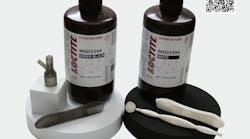INFINAM PEEK 9359 F Additive Filament
Based on PEEK (polyether ether ketone) technology, INFINAM PEEK 9359 F is a 3D printable filament with high-temperature and chemical-resistant properties that is ideal for the additive manufacturing of industrial plastic parts. The high-performance polymer can be processed in common extrusion-based 3D printing technologies such as fused filament fabrication (FFF) or fused deposition modeling (FDM).
The natural-colored PEEK filament, which has a diameter of .06 in. (1.75 mm), is wound on 17 oz. (500 g) spools for direct use in standard FFF/FDM 3D printers for PEEK materials. Thanks to its properties such as high mechanical strength, hydrolysis resistance or inherent flame retardancy, it is suitable for the production of lightweight and high-performance 3D parts for the aerospace, automotive, and oil & gas industries.
Compared to stainless steel, 3D parts made of INFINAM PEEK 9359 F are approximately 80% lighter and 30% tougher with great fatigue resistance. This combination of properties makes the filament a viable alternative to metal printing in lightweight applications. The material also provides wear resistance and low sliding friction.
3D components printed from INFINAM PEEK 9359 F can withstand long-lasting temperature effects of 482°F (250°C) or short-lasting temperature effects of over 572°F (300°C).
- excellent performance in heat resistance and chemical resistance
- good warpage resistance
- unique crystallization which gives significantly improved adhesion between layers in the vertical direction
- compared to 3D printed stainless-steel parts, it is 80% lighter in weight and 30% tougher with excellent fatigue resistance making it an ideal substitution to 3D printing metal
- superior wear resistance and low sliding friction which makes it suitable for producing lightweight structural parts
- long-term temperature resistance at 482°F (250°C) and short-term temperature resistance at or above 572°F (300°C)
- resists most organic and inorganic chemicals and only dissolves in concentrated sulfuric acid and nitric acid
- Inherently flame retardant with low smoke and toxicity
- Resistant to gamma radiation, 482°F (250°C) steam and hydrolysis
- better wave transmission performance than metal materials





